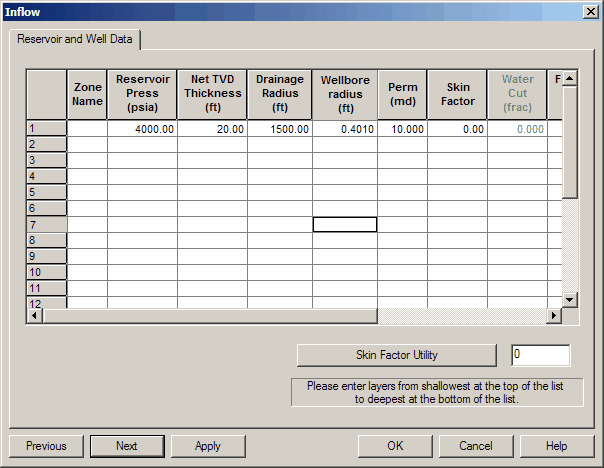|
<< Click to Display Table of Contents >> Darcy Injectivity Gas |
  
|
|
<< Click to Display Table of Contents >> Darcy Injectivity Gas |
  
|
Darcy Injectivity- Gas

The following items may be edited on the Injectivity Reservoir and Well Data Panel:
ZONE NAME:
RESERVOIR PRESSURE (psia): The average reservoir pressure in the well's drainage area and can be obtained from pressure buildup analysis.
NET TVD THICKNESS (ft): The height or thickness of the zone believed to contribute flow. It is usually obtained from well log analysis and should be consistent with the average permeability specified.
DRAINAGE RADIUS (ft): The distance between the well and the no-flow boundary created by off-setting wells in a developed pattern. It is equal to one half the square root of the well spacing: Rectangular drainage radius = 0.5 * ( 43560 * A ) where A is the spacing (acres.) Drainage Area Examples
WELLBORE RADIUS (ft): The radius obtained from the caliper log, or the drill bit size when hole washout is not a problem. The Wellbore Radius Examples may be used as a guideline.
PERMEABILITY (md): The absolute (i.e., fluid independent) permeability averaged over the net thickness of the zone. These values are typically obtained from measurements on core samples using air as the fluid medium. Effective (i.e., fluid dependent) permeability estimates can be obtained from pressure transient analysis. These estimates can then be converted to absolute permeability values.
SKIN FACTOR: A dimensionless number representing the near wellbore condition of damage or stimulation, where a positive factor indicates damage and a negative factor indicates stimulation. This factor is obtained from pressure transient analysis of drawdown or buildup data. It is important to remember that the completion effects are included in this number, i.e. horizontal wellbore, perforation density, gravel pack, etc..
WATER CUT: The fraction of the total liquid flow stream that is made up of water. In the results, fluid rate data is reported as TOTAL fluid which includes this water cut fraction.
FRACTURE PRESSURE (psia): The pressure at which the slope of the injectivity index changes as the reservoir begins to break-down Typical frac gradients run from 0.7 to 1.2 psi/ft.
MAX RATE (mscfpd): Unlike an IPR curve, the Injectivity performance of the reservoir is bounded only by the ability to pump more fluids into the formation. To set a reasonable bound on the Injectivity, enter the highest anticipated injection rate here and the IPR calculations will build a suite of points to cover rates from 0 to the value you entered. Entering a very large number will ensure a valid intersection is reached, but may reduce the resolution of the ipr curve.
POST FRAC SKIN (): The skin factor of the formation after fracturing. This value should be less than than the below frac skin.
CHOKE:
*Note: This Help File update will be completed at a later time.